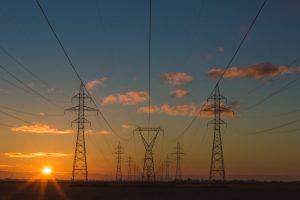Sierra Club Elects First All-Female Board Executive Committee
Monday, May 22, 2017
Read moreDedicated To People, The Planet, and All Its Inhabitants – Since 1996

Monday, May 22, 2017
Read more“President Trump’s proposed 2018 budget is a full-scale attack on America’s most fundamental health and safety protections. It would gut[…]
Read moreBy EDF Blogs
 By Christie Hicks, Manager, Clean Energy Regulatory Implementation
By Christie Hicks, Manager, Clean Energy Regulatory Implementation
Many experts anticipate the electric utility industry evolving more in the next 10 years than it has in the past 100.
So noted the Illinois Commerce Commission (ICC), when it recently initiated the “NextGrid” Utility of the Future Study. NextGrid is a statewide, collaborative effort to rethink the roles of the utility, the customer, and energy solution providers in a 21st-century electric grid.
The ICC invited stakeholders to participate in NextGrid, welcoming suggestions for how the process should work. Environmental Defense Fund (EDF), partnering with the Citizens Utility Board (CUB), recommended NextGrid ensure that upcoming technological advances enable a more dynamic grid – one that is cleaner, affordable, reliable, equitable, and more responsive to customer needs. But how do we get there?
Smart evolution
Over the last several years, Illinois has taken steps that put it on the forefront of the smart grid revolution. In 2011, Illinois’ Energy Infrastructure Modernization Act propelled the state’s two largest electric utilities, Commonwealth Edison (ComEd) and Ameren, to undertake billions of dollars in smart-grid investments, like AMI (advanced metering infrastructure). As a result, smart meters will be deployed throughout most of the state by 2019, and customers are anxious to start enjoying the benefits, like easier access to energy-use data and enhanced efficiency.
What’s next for NextGrid – Illinois’ ‘Utility of the Future’ process
Click To Tweet
Further underlining its role as a clean-energy innovator, Illinois passed the bipartisan Future Energy Jobs Act (FEJA) in December of last year. Utilizing the new smart grid infrastructure in the state, FEJA encourages the adoption of distributed energy resources such as rooftop solar; expands the state’s existing energy efficiency standard; and includes a focus on economically-disadvantaged groups (like through the new solar job training program). The historic legislation provides exciting opportunities for Illinoisans to enjoy the economic, health, and societal benefits of clean energy advances.
The NextGrid journey
FEJA takes effect on June 1, and the ICC is responsible for implementing many of the new law’s requirements. To kick-start the law into action, ICC will use NextGrid as an 18-month customer-focused and collaborative study led by an outside, expert facilitator. Here’s what NextGrid will do:
Charting a path
Numerous innovations in energy-related technology are on the horizon, and many new, innovative products and services are already available. Meanwhile, customer expectations for utilities are evolving: Customers want more information about, and greater control over, their energy sources and use.
Fortunately, a changing energy system presents many opportunities for building a smarter, more connected electric grid. For example, system reliability – which was a key selling point of advanced metering investments – can be improved using a number of tools, from solar panels to microgrids to battery storage. Rooftop and community solar are largely nonexistent in Illinois right now, but the Future Energy Jobs Act will facilitate significant growth in the next decade (it’s already starting to take off in Chicago).
The ICC should prioritize system reliability, as well as equitable access to these new opportunities.
First, we recommend an educational process to develop a “problem statement” that provides guidance and establishes a sound analytical foundation. EDF and CUB warned against putting the cart before the horse – i.e. before the Commission can make policy decisions or identify potential areas of consensus or disagreement, everyone should have a strong knowledge base for the emerging technologies, system trends, opportunities, and challenges. This phase of NextGrid should be facilitated by a neutral third-party, such as a university, who will invite local and national experts to provide input on identified trends and possible future scenarios.
While some customers put reliability at the top of their list, others say affordability is most important, and still others focus on reduced air and water pollution.
Once the problem statement has been created, working groups can be established to identify, evaluate, score, and test possible future scenarios. Scenarios could include significant adoption of rooftop solar, innovative energy efficiency measures, or increased electric vehicle adoption, and the impact of each will be measured against the possibility of maintaining the status quo.
Led by a process management facilitator with expertise in energy system regulatory processes, this phase would consider what customers expect and desire out of the energy system. This will be different for different people: While some customers put reliability at the top of their list, others say affordability is most important, and still others focus on reduced air and water pollution. Environmental sustainability, energy affordability, system reliability, customer satisfaction, and equity should all be considered. Then, the parties should consider how to use new technologies, services, third parties, market designs, and other solutions identified in the first phase to achieve their goals.
The formal process should kick off this summer. EDF and CUB are excited to engage in NextGrid and will work to ensure that it paves the way for a cost-effective, environmentally sustainable energy future for Illinois.
A new World Wildlife Fund (WWF) report finds that farmed shrimp from Thailand, Vietnam, and India could be traced back to their countries of origin with more than 98 percent confidence through a process known as elemental profiling. With greater refine…
Read more23 May, 2017 – From the Himalayas to Switzerland, the world’s glaciers are melting – threatening vital water supplies and increasing the risk of sea level rise.
The post World’s vanishing glaciers put millions at risk appeared first on Climate News Network.
Read moreThe Environmental Protection Agency (EPA) is delaying common sense standards to reduce methane and other toxic pollution from landfills –[…]
Read moreBy Mandy Warner
 This weekend is Memorial Day – the unofficial start to summer. That means kids across the country – and adults too – are counting down the days until summer vacation.
This weekend is Memorial Day – the unofficial start to summer. That means kids across the country – and adults too – are counting down the days until summer vacation.
Whether your plans include going to a beach, visiting a national park, or just letting your kids play outside in the sprinklers, the Environmental Protection Agency (EPA) plays an important role in making your summer healthier and safer – in ways you might not realize.
Here are four examples of how EPA improves summers for all Americans:
Smog comes from pollution emitted from cars, power plants, and other sources. It can lead to asthma attacks, heart attacks and even deaths.
The summer smog season has already started in most parts of the country. A number of “code orange” days – the terms for days when the air may be too dangerous for some people, like children with asthma and seniors with heart conditions, to be outdoors – have already been issued.
Smog has improved significantly in recent decades, thanks to EPA and state leadership, but air quality in the U.S. continues to be a serious problem that can jeopardize public health and limit many individuals’ freedom to spend time outdoors. The American Lung Association estimates that more than a third of Americans live in areas with unhealthy levels of smog.
EPA has worked for decades to reduce smog, most recently when the agency issued new standards for smog in 2015. Once they’re in effect, those standards will prevent 230,000 asthma attacks among children every year. That doesn’t include the benefits for California, which EPA calculated separately – the smog standards will prevent another 160,000 asthma attacks among children in that state alone.
Unfortunately, smog standards are under attack in Congress. Several bills to delay and fundamentally alter how these and other air pollution standards are set are now moving through the Senate. Additionally, President Trump’s proposed budget for 2018 cuts funding for the air monitoring that warns families about “Code Red” and “Code Orange” days – the days when air quality reaches unhealthy levels – by almost one third.
Many of us look forward to summer for the opportunity to spend time on the beach.
Last year, U.S. beach attendance was almost 360 million (more than the entire U.S. population!).
Unfortunately, beaches can be shut down by pollution – including raw sewage, which can expose swimmers to harmful microorganisms called “pathogens” that can make people sick.
An analysis done by the Natural Resources Defense Council a few years ago looked at water samples from 3,485 coastal U.S. beaches – and found that 10 percent of them were above EPA’s benchmark for swimmer safety. The analysis also notes that an estimated 3.5 million people are sickened every year from contact with raw sewage.
EPA – in partnership with states, local governments, and others – works to protect our nation’s beaches. The agency enforces laws and administers programs that regulate sources of water pollution at beaches, conducts leading scientific research on pathogens and sets national standards and criteria, funds grants to states and local governments to help protect our beaches, provides information to the public about water quality, and more. This work helps ensure that America’s beaches stay safe, clean, and open for visitors.
Here are a few examples of beach monitoring and cleanup grants distributed by EPA:
President Trump’s proposed budget for EPA would eliminate the beach monitoring grants program, among many other things that could impact the health of our nation’s beaches.
National parks are a popular destination for summer vacationers across the country.
According to the National Park Service, there were over 307 million visits to our national parks last year and those visitors spent $16.9 billion in surrounding communities. This spending supported 295,000 jobs and contributed $32 billion to economic output nationally.
EPA and other agencies monitor visibility at 155 national parks and wilderness areas across the country. Unfortunately, many national parks suffer from haze – a form of pollution – that can tarnish scenic vistas and create health problems for visitors.
EPA’s program to reduce haze and other pollution harming our parks has led to measurable improvements in visibility. However, according to the National Parks and Conservation Association, three out of four of our most iconic national parks struggle with unhealthy air, and visitors miss about 50 miles of scenery because of haze.
EPA’s work to reduce the pollution affecting our parks is under threat by Administrator Scott Pruitt, who sued EPA over a plan to reduce haze when he was Attorney General of Oklahoma.
Climate change affects virtually every facet of our lives and can exacerbate all of the problems listed above – more smoggy days, rising sea levels and more pathogens potentially spreading at beaches, and worse haze in our parks.
Extreme summer heat can also cause illness and death, and climate change is increasing the frequency and severity of those potentially deadly heat waves.
EPA has provided essential leadership to address climate change – including setting standards that would reduce pollution from power plants, cars, trucks, oil and gas operations, and more. Actions underway by EPA Administrator Scott Pruitt and severe budget cuts in President Trump’s proposed EPA budget could significantly harm the progress we’ve made and delay urgently needed protections for public health and our climate.
President Trump and Administrator Pruitt have indicated they will seek to unravel numerous climate protections, including the Clean Power Plan. Their proposed budget for EPA and other agencies undermines climate research and policies, including by zeroing out the U.S. Climate Action Plan.
Protecting the things that we love about summer
EPA’s work protects our air, our water, our beautiful beaches and parks – and most important, the health and safety of our families. As you enjoy your summer, please remember how important it is to protect the qualities that make summer great.
We need a strong EPA – now and all year long. More than just our summers are at stake.
9 May, 2017 − Attacks on Amazon Indians and on their land rights are threatening vital areas of rainforest indigenous people have preserved for centuries.
The post Amazon’s Indians and rainforest under attack appeared first on Climate News Network.
Read more
With clothing producers like VF going fur-free and expanding their policy to other animal products, there is reason to hope for millions of animals caught up in this cruel industry. Above, at a rabbit fur farm in China, rabbits are packed so tightly in cages, they cannot stand. Photo by VShine
No more skin in the game. That’s the message from the parent company of more than two dozen popular clothing brands, including The North Face, Vans, Timberland, Wrangler, and Nautica, which today announced it will cleanse its supply chain and all of its garments of animal fur, angora, and exotic leather. VF Corporation has partnered . . .
The post The North Face, Timberland and other iconic American brands to ban fur, angora, and exotic skins appeared first on A Humane Nation.
By Lindsay McCormick
Every day we are exposed to potentially hazardous chemicals we can’t see —chemicals used in everything from the clothes we wear to the lotions we use and even the couch we sit on. Synthetic chemicals are used to make 96% of products in the United States. Yet scientific research continues to link chemicals in common use to health effects like cancer, infertility, and asthma.
EDF selected 10 individuals across the country to wear a novel wristband technology designed to detect chemicals in their environment for one week – including Gordon, Karen, and Averi.
 Gordon is a lieutenant for the Memphis Fire Department. Gordon’s wristband detected 16 chemicals, including gamma-chlordane, a pesticide that has been banned in the U.S. since the 1980s, and 3,4-dichlorophenyl isocyanate, a “chemical intermediate,” which is reportedly used exclusively for chemical manufacturing processes. While there were no fires to fight the week he wore the wristband, Gordon wondered if he came into contact with these chemicals from a site visit to a location that formerly housed chemical stockpiles, his local auto repair shop, the nearby highway – or even his fire suit.
Gordon is a lieutenant for the Memphis Fire Department. Gordon’s wristband detected 16 chemicals, including gamma-chlordane, a pesticide that has been banned in the U.S. since the 1980s, and 3,4-dichlorophenyl isocyanate, a “chemical intermediate,” which is reportedly used exclusively for chemical manufacturing processes. While there were no fires to fight the week he wore the wristband, Gordon wondered if he came into contact with these chemicals from a site visit to a location that formerly housed chemical stockpiles, his local auto repair shop, the nearby highway – or even his fire suit.
Karen is an 8th grade science teacher who engages her students in citizen science projects like measuring air pollutants using portable air monitors. The chemical-detecting wristband was another great teaching tool for Karen’s students. Among other chemicals, Karen’s wristband detected the flame retardant BDE 47, which was phased out of U.S. production in the mid-2000s due to health impacts on the developing brain and persistence in the environment. Karen hopes that personal exposure monitors like the wristband will become more available to the general public in the future, noting that her students would love to wear the wristbands themselves: “The students are very curious. They love this project!”
 Averi is a student at The College of Wooster, currently doing her senior research project on sustainable interior design. Averi’s wristband detected several chemicals that can be found in personal care products – such as lotions, shampoos and conditioners – including the fragrance enhancer diethyl phthalate, the preservative benzyl benzoate and the synthetic fragrance galaxolide. After wearing the wristband, Averi reflected, “It struck me that I may be interacting with the most toxic chemicals when I am showering… in the place where I am trying to get clean.”
Averi is a student at The College of Wooster, currently doing her senior research project on sustainable interior design. Averi’s wristband detected several chemicals that can be found in personal care products – such as lotions, shampoos and conditioners – including the fragrance enhancer diethyl phthalate, the preservative benzyl benzoate and the synthetic fragrance galaxolide. After wearing the wristband, Averi reflected, “It struck me that I may be interacting with the most toxic chemicals when I am showering… in the place where I am trying to get clean.”
The wristbands and other emerging chemical monitoring technologies promise to transform our understanding of environmental exposures to chemicals – by making the invisible, visible – and in so doing, open up new opportunities for reducing exposures.
Learn more about the project and what our participants had to say about the experience here.